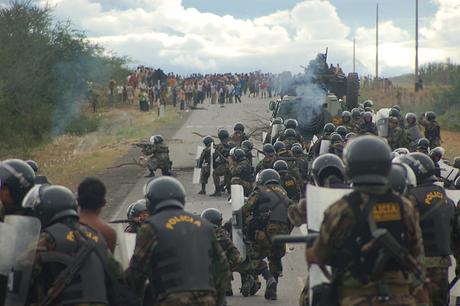Indians accused over “Devil’s Bend” killings go on trial
May 26, 2014
 © Thomas Quirynen
© Thomas QuirynenThis page was last updated in 2014 and may contain language which is now outdated.
Fifty-three people go on trial in Peru today, charged in connection with violent clashes between Indigenous protesters and police five years ago that left thirty-three dead.
The violence erupted in June 2009 after more than 50 days of nationwide protests led by Peru’s Amazon Indians over government plans to strip the Indians of their rights, and open up the Amazon to oil drilling and mining.
The clashes took place in Peru’s northern Amazon town of Bagua, after police confronted Indigenous protesters who had peacefully blockaded a highway at a place known as “Devil’s Bend” for almost two months.
Twenty-three police officers, five Indians and five civilians were killed and more than 200 injured during the incident, according to a report by Peru’s Ombudsman. Unofficial reports have claimed the death toll was much higher.
Amongst those charged is Alberto Pizango, the president of Peru’s Amazon Indian Organization AIDESEP. The prosecution has called for Pizango to be imprisoned for life for “inciting violence”.
Since the clashes, several of the government’s controversial decrees have been repealed. In 2011, Peru’s President Ollanta Humala approved a law designed to guarantee Indigenous peoples’ right to free, prior and informed consent to any projects affecting them and their lands.
However, since then the government has approved a controversial expansion of the massive Camisea gas project, even though it will penetrate deep into the territory of uncontacted Indians.
Peru’s government has been heavily criticized by both Indigenous people and families of the deceased police officers for its failure to prevent the violence.
No police officers have yet been brought to trial.
Read Survival’s eyewitness report of the Bagua killings here.


